I look up from the boat and realize we’re a lot closer to shore than I thought. The gentle rhythm of the boat, combined with an early morning start, must have put me in a sleepy slumber. Christine gives me a gentle nudge and points in the direction of the eager onlookers. All the passengers on board have begun to gather around the left side of the boat, gazing at the masses of wooden paddleboats that are beginning to assemble in the water. We all begin to search the waters, hoping to get our first glimpse of the famous Oslob whale sharks. Most of the passengers on our boat are here to swim with the whale sharks, and in a short moment they too will join the hordes of tourists being shuttled in and out of the waters of Oslob. Unfortunately we will not be part of that group.
Don’t get us wrong, we’d love to be able to experience these majestic animals in their up close and natural habitat. In fact, when we first started planning our Philippines trip swimming with whale sharks was high on our bucket list. And that was a really tough list to make. Coming into this trip we were super excited about planning our list of things to do in the Philippines. We scoured the Internet, pulling apart every Lonely Planet forum and making our way through the masses of blog articles compiled by eager travelers and locals alike. From the thousands of options out there we barely managed to narrow it down into a list of ten. Of those ten choices one that really stood out was the incredible opportunity to swim with whale sharks in Oslob, Cebu.
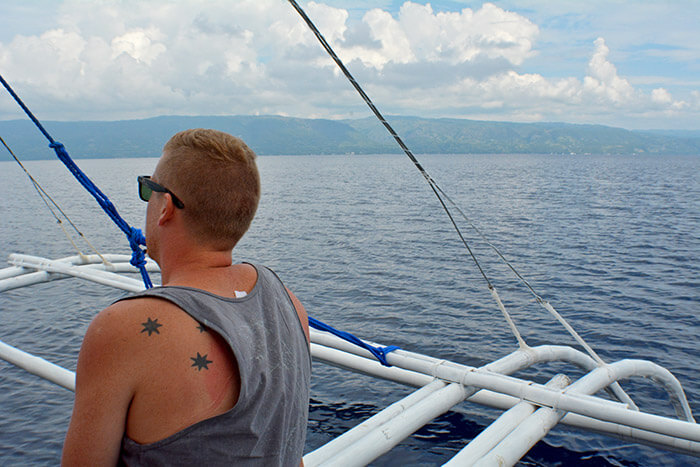
Years ago Christine was fortunate enough to come across a couple of whale sharks while diving in Honduras, which can be rare, and we’d heard it was pretty easy to replicate those experiences in Cebu. Pictures on the Internet did nothing but fuel our wanderlust. At the time however, little did we know about the potential affects that this could have on the famous whale sharks in Cebu. Like many animal tourist activities, there are always a number of factors to consider regarding animal welfare, sustainability and overall community impact. Having a swim with the whale sharks might sound like a fun idea, but it quickly turns from interesting attraction to animal exploitation if tourist interaction is impacting the species and it’s habitat.
Scene From the Whale Shark Tours in Cebu
When we were taking the boat from Bohol to Cebu we happened to dock at Oslob, so we were able to witness first hand the scene at the beach. Picture an area no bigger than a football pitch, about 50 odd meters from the beach and full to the brim with boats and people snorkelling around. From the surface we couldn’t get a full gauge on what was going on, but do a simple search and amongst the amazing whale shark selfies you’ll see pictures of people touching and holding onto the animals. It’s crowded and you don’t seem to get long in the pit. Tour guides roll you in and out at a rate to keep up with the continual flow of boats arriving, while feeding the animals to keep them attracted. Even seeing this was enough to make us feel confident we made the right decision, with the tour looking more like a zoo than an authentic nature exhibition.
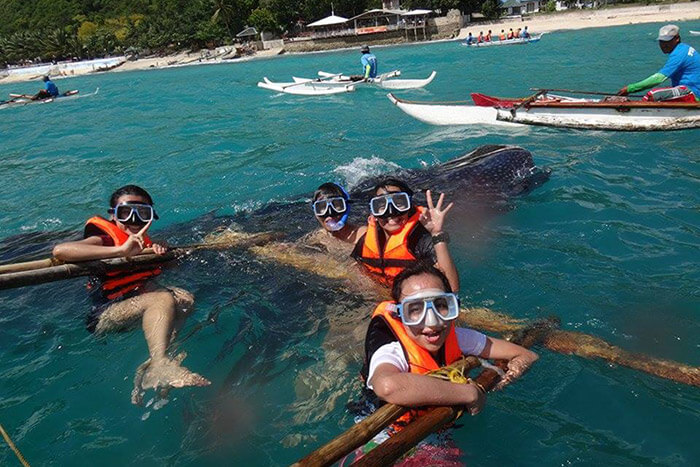
But we didn’t want to make a snap judgement based on our personal experience alone. We’re far from experts in marine biology so we decided to chat with actual marine biologists who could give us the scoop on whether this activity is detrimental to the animals. Here’s what we learned.
Want to find other ethical whale shark experiences while traveling? Check out our full guide to Swimming with Whale Sharks Around the World
The Impact on the Whale Sharks
Many international marine conservation organizations have spoken about the negative affects of the whale shark tours in Oslob. Reef-World, a UK based conservation group focussed in Southeast Asia, and their United Nations Environment Programme initiative Green Fins, have “come out against the tourism activities in Oslob, noting that the practice of feeding wildlife is unsustainable”. There are also many local initiatives in the Philippines that are working on monitoring and researching the whale sharks visiting Oslob. The Large Marine Vertebraes Project Philippines (LAMAVE) in particular is leading the way in research surrounding whale sharks in the Philippines. They also have the difficult task of juggling marine conservation, local community development, education initiatives and Philippine bureaucracy.
The official conservation status for whale sharks is ‘vulnerable and declining’, so now really isn’t the time to take a gamble on how much of an impact this tourist activity is having. A study conducted by marine biologists observing Oslob whale sharks supports this sentiment by stating, “poor and unregulated whale shark tourism can lead to short and potentially long-term impacts, like behavioral change and displacement from critical habitats” (Source). Some of these behavioral and habitat changes include:
Decrease in Nutritional Value
The main reason the whale sharks visit Oslob everyday, and keep returning, is because they’re getting fed. Everyday fishermen attract the sharks to the site by feeding them one type of krill (uyap) that they purchase in bulk. Because of this the whale sharks are now spending up to 6 hours feeing in Oslob, losing out on some of the key nutrients that they gain from foraging naturally. With over a hundred different types of nutrients on offer the whale sharks are only getting a handful because of the lack of quality in their feed. Think of it like a human eating the same thing all day, everyday. One of the concerns is the affect this may have down the line with growth and reproduction.
Migration Patterns of Whale Sharks
Whale sharks are highly mobile animals, so by enticing the whale sharks to stay in one spot it is interfering with their natural movements and migration pattern (Source). One whale shark in particular has been known to stick around for over a year in Oslob. It’s still too early to tell the lasting affects of this, but marine biologists predict it could alter their breeding habits and ultimately their reproduction. Considering they’re a vulnerable species any risks with reproduction should be taken very seriously.
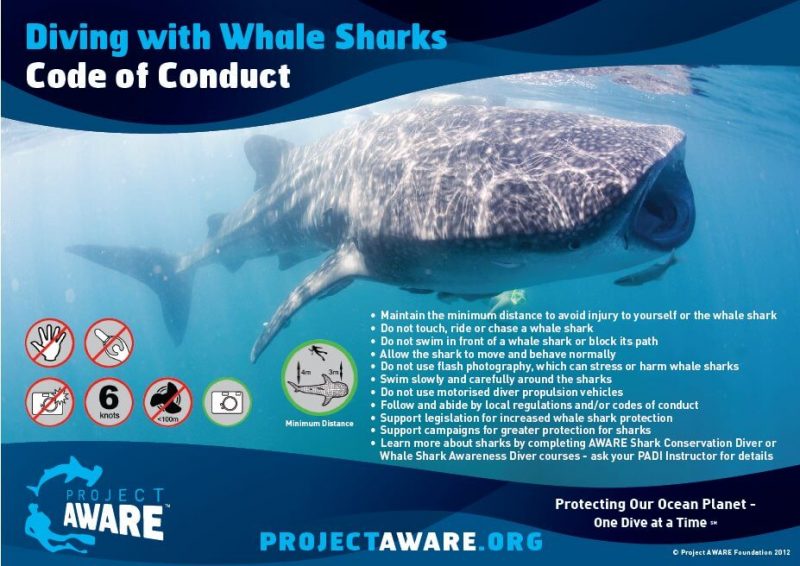
No Touching the Whale Sharks!
Although there are strict rules and regulations prohibiting interaction with the whale sharks, with several hundreds visits a day it’s inevitable that there’ll be some daily contact. Whale sharks bump into the boats and have evidence of cuts and scarring. Researchers have also reported that whale sharks now associate other non-tourist related boats with feeding, causing them to get injured when they come too close to motors and oars.
Along with that there is also the growing concern of increased tourist contact. As the popularity of the tours increases, so does the lack of compliance with local regulations and guidelines. For example, the 2 meter minimum distance of tourist to whale shark is very rarely enforced, with up to 97% of cases breaking the rule in 2014 according to a thorough research study (Source). This non-compliant regulation comes down to a lack of respect for the guidelines from not only the growing pressure on the tourism industry, but also the tourists joining the tours searching for that ‘ultimate selfie’.
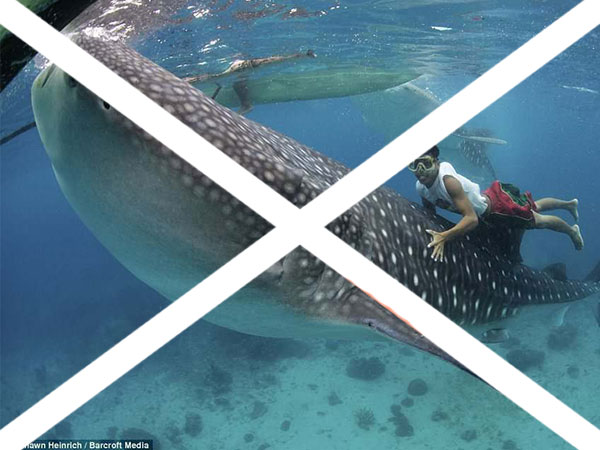
What To Do Now?
As responsible tourism advocates we hope to inform and present a different side of the picture. By writing this article we’d love to see more tourists became aware of all the facts, so they can make an informed decision on their travel plans.
What we’re definitely not doing is asking everyone to suddenly stop visiting overnight. The affect this would have for the whale shark population dependent on the food, as well as the local population dependent on the income, would be disastrous. Rather, we’d like to hear more people talking about this and putting pressure on the tour agencies and local authorities to start regulating the industry more closely. Which should lead towards developing a strategy to ensure the safety and health of the whale sharks going into the future, as well as the education to tourists and locals alike. It won’t happen overnight, but as conscious travellers we can start to make changes slowly. Eventually, just like pressure on elephant riding tours and tiger temples in Thailand, there will be enough voice to support the issue.
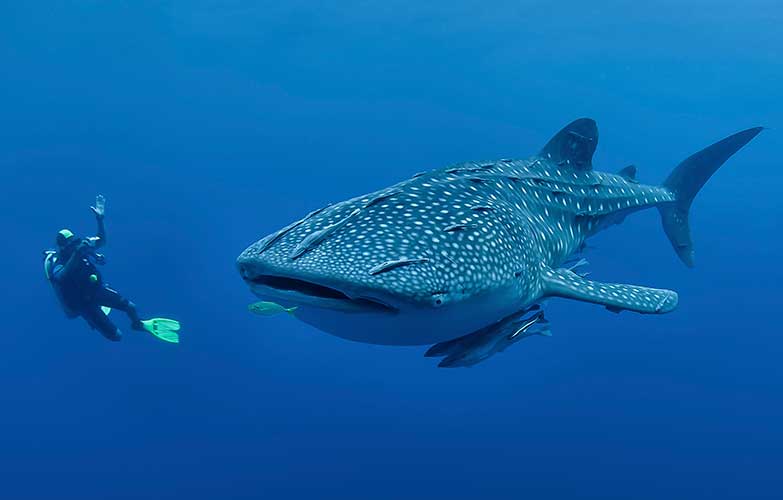
Responsible Tourism in the Philippines
So if you shouldn’t swim with the whale sharks, what should you do? Luckily there’s no shortage of amazing responsible tourism opportunities to view marine life in the Philippines: like being able to swim with turtles on Apo Island only a couple of hours south of Oslob. And unlike the negative affects of the whale shark tours in Cebu, this activity actually supports marine conservation and provides alternative income for the old turtle fishermen who now work as guides. This is an observational activity, with strictly no feeding or touching, but was by far one of our best travel experiences from our six months volunteering and traveling around the Philippines.
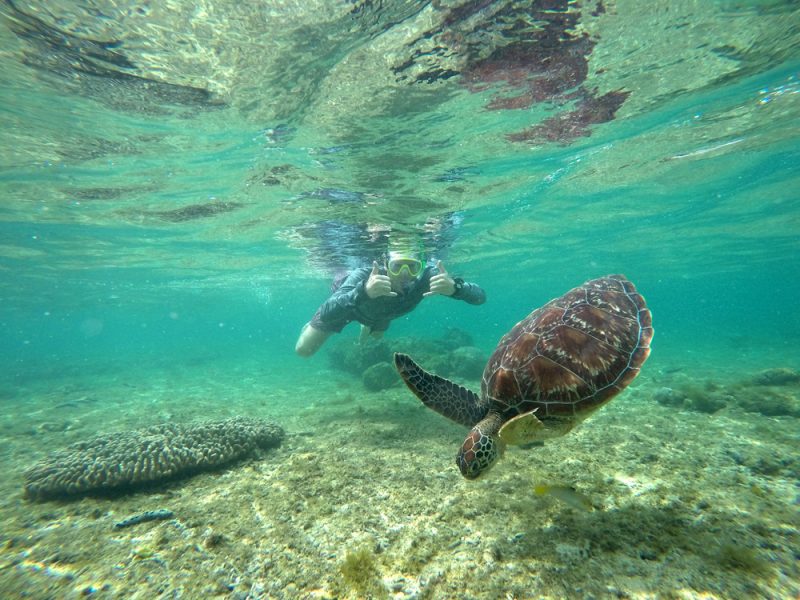
And if you really had your heart set on seeing the whale sharks then there are always opportunities with reputable dive companies that see them in their natural habitat, without feeding. Other locations off the coast of Dumaguete, Donsol and Pintuyan are known for whale sharks in the right season. Pintuyan in particular, in Southern Leyte, is known for its responsible interaction with wild whale sharks. Our best suggestion is to do your research, which really depends on the time of year you visit the Philippines. After that get in contact with dive shops for further information and they’ll help you out.
So to everyone thinking about the tours, although you’re free to make up your own mind, we would strongly urge you to consider all factors before booking your tour. And if you were originally planning on doing this (remember we were also), it’s not that you’re terrible and want to destroy the whale sharks, it’s just often hard to really know all sides. Hopefully now you do.

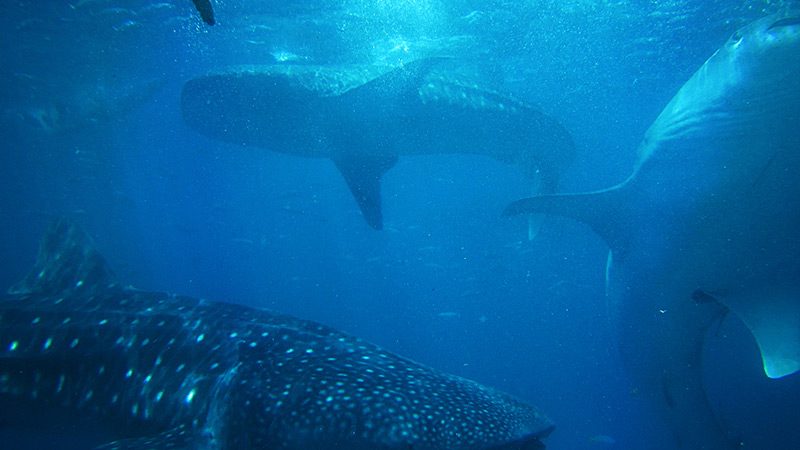





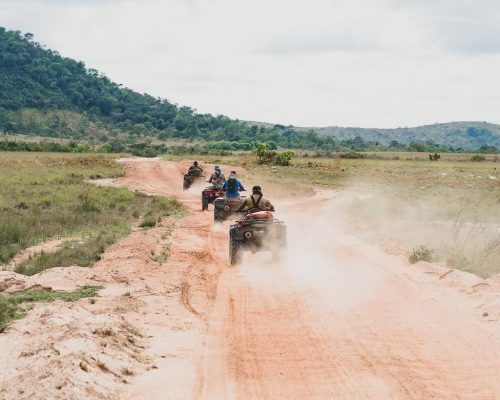

I can only say that you did the right thing!
Thanks Claudia! We think so too 🙂
I’m so glad that you and others are writing about these issues to at the very least bring more awareness. Just a few years ago we would likely have been some of the people contributing to this sad situation in Cebu due to lack of understanding on the effects.
We actually have swam with whale sharks around the Baja of Mexico. We were on a snorkeling tour out of La Paz and the driver of the boat got a call saying that there were whale sharks in the area. Apparently it was the time of year when they migrate through the area. He asked our group if we wanted to go and see them which of course we all did. Before long we spotted these magnificent giants and our guide told us to jump overboard to get a closer look. He said we were to keep a distance and not to touch them or feed them. It was an amazing experience and as far as I could tell it was not an organized thing, rather just lucky timing.
Looking back now and reading your article I wonder if there was any potential ill effect. I suppose the big danger is that if enough tourists start asking for this experience the tour operators could see an opportunity and start feeding the whale sharks to make them stay as they do in Cebu.
Thanks a lot Sarah. It’s awesome to have your support. As we said in the article, we were pretty close to doing it as well, so we’re definitely not judging anyone. Luckily we had some good advice and were able to do more research.
Your experience in Baja sounds so awesome! What an incredibly lucky encounter. If you come across them naturally and don’t touch them i can’t imagine why it’d be dangerous. The biggest concern surrounding this topic is actively and repetitively baiting the sharks to come back to the area. Unfortunately this occurs because tourist demand has forced the industry to increase the supply. If more people wanted these experiences it would pressure the tourism industry to find ways to provide the tours…. that’s when it gets dangerous. Hopefully more people continue to write about this and put more pressure on the tourism industry and other tourists not to partake.
Very helpful and informative post, as a marine biologist, completely agree with all the scientific facts presented in ths post. I hope travellers and other travel bloggers who read this take it as that – an informative post on ethical tourism that helps increase the awareness and knowledge of partaking in these activities. Do you know much about whether it is done sustainably (without feeding, less crowds, not touching etc) in other parts of the world?
Thanks so much Samiya. It means a lot to have your support and encouragement, especially as an expert in the field 🙂 I know areas in Australia offer sustainable tours, and it also happens down in Mexico (they try to promote sustainability), but I really couldn’t report on any facts. But i’ll be sure to find out whenever I get to the area.
I couldn’t agree with this artical more – if only there were more travellers like you!!
Thanks so much Paige! We really appreciate the support and encouragement 🙂
Your article is an eye opener of those who patronize this deplorable situation in Oslob. Hoping the authorities(be it local or national) will realize what’s pointed out here.
There are sea turtles just 20 minutes from Oslob. But, we are not promoting it for fear of having the same negative impact to the habitat of this wonderful creatures that freely live here. We are contended and happy by the knowledge that they are here without the threat of being exploited.
Thanks Ramie. It’s interesting that you mention the sea turtles, because if demand for that activity grows they too could be in a similar situation as the whale sharks. At the moment there are a lot of differences between what is being offered on Apo Island, with non-feeding being the biggest and most important. As long as they don’t start feeding the turtles in the future, and the guides/industry doesn’t take shortcuts, there is no reason why this can’t continue as a sustainable tourist attraction to help develop the island. It really comes down to how the tourism industry decides to respect the rules and enforce the guidelines.
I swam with them in Coral Bay, Western Australia last June. I’m not supportive of unethical practices and am big in animal rights. When I did it though, there was no feeding and no touching at all. We were the only boat in deep ocean water and it took a while before spotting one, with no guarantees. Once we did, a small group at a time would go swim out to find the whale shark that was spotted. We got close but there was a safe distance we had to maintain around them, and the boat didn’t get close either (had to swim a good distance). Really an incredible experience but like everything that involves wildlife, it has to be done right to make sure you’re not harming the animal. Thanks for sharing. It is so important to spread awareness.
Thanks for the comment Alyssa. Your experience in Western Australia sounds awesome. A perfect example of how animal tourism can be conducted responsibly and without damaging the whale shark species. Unfortunately at Oslob this couldn’t be further from what you witnessed at Coral Bay. We need more people writing about responsible activities like this to demonstrate effective practices. Thanks for sharing.
I love this article guys, I would love to swim with whale sharks and will definitely ensure to do my research before hand and won’t be doing it in Cebu
Great stuff Katie! Glad you enjoyed the article and want to help support responsible tourism!
Thank you for this article. I really wanted to swim with whale sharks too, but the more and more I read about it, the more I pulled away from the thought. You guys did the right thing and went even further by talking to biologists who have been researching the harmful impact these tours have on the sharks. Hopefully more people will read articles like this and think about their choices before partaking!
Thanks a lot Sadie! We really hope more people read this and become aware as well 🙂 It would be awesome if all travelers started to improve their research before taking off on trips and booking tours. Slowly we’re all making an impact.
Hi – I swam with Whale sharks in Mexico (out of Cancun), but also had to think hard about whether to do it or not.
Unlike your experience they don’t feed the Sharks, but the tourist industry around swimming with them is big money and has boomed substantially. It’s a seasonal activity as they only see the Sharks when they migrate.
Rules around number of people allowed in the water at one time etc are routinely ignored so that tourists get the chance to see them up close – although I didn’t see anyone touching the Sharks… But you could tell they were getting annoyed as they dove way below us to get away from the ruckus on the surface.
Apparently they can have groups of whale sharks of up to 200 individuals at some times during the year – but having seen the effect when there are only 3 around and still the same number of boats – it doesn’t seem sustainable to me…
That said seeing these creatures so close up was an amazing experience – I almost spat my snorkel out when I was face to face with one! (Actually not that close, but they are so huge it feels like it!)
Katie
Hey Katie thanks for commenting and telling us about your experience. A lot of different places around the world are offering similar experiences, some set up ok, some not so much. It sounds like in Mexico sometimes it’s a little hit and miss, but it’s hard to comment without knowing a whole lot about it. If done correctly there is no reason why people shouldn’t be able to witness these amazing animals, but if the industry cuts corners to accommodate tourists, that’s when any experience will start to jeopardize the whale sharks. Hopefully this article raises more awareness for all thinking about booking a similar experience, wherever in the world it may be. Thanks 🙂
I’m far more cynical and I think people will only understand if we boycott the business until the selfish, narcissist acts are kept in check.
Good on you for mentioning the alternative locations! There is only one thing left for me to do and that’s to share this post.
Thanks a lot Nicholas for supporting our post and sharing it 🙂
I freaking love the ocean and whale sharks, however I opted to swim with them – both out of curiosity for how everything was conducted but also because they’re amazing animals (I’ve scuba dived with them a few times).
After speaking to an Aussie freediver who runs a company out there his bottom line was “if they weren’t bringing in tourists they’d have already been finned for the shark finned industry and eaten”
It’s a pretty blunt and the ugly side of what’s happening in the ocean these days but these gentle giants are in decline and endangered because of illegal fishing, poaching and the shark fin industry.
Yes, swimming with them isn’t ideal and yes there are some major changes that need to be made (numbers and contact being the main items on the agenda), but I’d rather see a live whaleshark than a dead one!
That being said though – totally respect your decision guys 🙂
Hey Chris thanks for commenting. We always appreciate hearing different opinions on this issue and totally respect your decision… even if we don’t completely agree haha. I can definitely see the Aussie freedivers point of view regarding the shark fin industry, but that also shouldn’t happen. Clearly there needs to be more regulation all round to help fix this issue. At the end of the day we all just want to see these amazing animals thrive in a natural environment that doesn’t affect them in the long run. If that can be organized around the tourism industry then we’re all for it 🙂
We had a similar experience outside of Cancun. I didn’t realize until we were already there how bad it can get with the boats circling and pursuing the sharks. I felt bad for them. Although, they DO stress no touching of the sharks, which is good, but I still can’t imagine that chasing them down and having a bunch of noisy boats circling is good for them.
In Honduras, it was a much better experience. The safety policies are observed much better.
Thanks so much for your perspective Talon. Which company did you go with? We have been invited to check out a place in Cancun and we’re tempted to, just to report on it because many people ask us about that experience. I’ve heard Honduras is much better as well. Christine dove with whale sharks when she did her scuba training there and it was pretty legit.
Great article!
I’m living in Dumaguete for a few years already and witnessed how the whale shark watching site evolved from a simple nipa hut to a mass tourism site. I swam with the whalesharks in Oslob around 10 times. The last time was two years ago and I was really shocked how crowded it got there. Hundreds of people from all over the world. Years before that, you could only meet some adventurer’s and locals at the whaleshark watching site.
After my last time visiting the whalesharks, I realized that the whole “attraction” isn’t sustainable anymore. Probably it never was, because locals were feeding them already on my first visit in 2009.
To minimize the impact of tourism on the whalsharks in Oslob and to ensure the income of the locals I see only one way. Strictly limit the number of visitors, like on the Galapagos Islands, and increase the “entrance fee” to an amount that ensures the locals a decent life. Win for the whalesharks, win for the people.
Thanks for bringing up this topic! 🙂
Hey Hans thanks for the comment and kind words 🙂 I bet it has been an interesting observation to see how Oslob has evolved. I bet back in the day it was a pretty harmless interaction when it was small scale, but unfortunately these activities grow into money makers at the expense of the animals. I like your suggestions of limiting tourists and uping the fees. Could be a good win-win if handled correctly.
Love you article! Keep writing! Amazing how foreigners cares more than Filipinos out there! ?
There are also a lot of Filipinos out there that care, they just need to hear more stories about it 🙂 One of our good Filipina friends is the person who actually alerted us to this issue.
“Amazing how foreigners cares more than Filipinos out there! ?” – Norma
Sorry, this is a very offensive comment, likely due to simple ignorance, and I felt it needed a reply. Like conditions that exist all over the world, the suggestion that people don’t “care” about their own ‘homes’ can be very erroneous. These are often views from persons who come from “1st World” nations, where two factors integral to the unfortunate conditions of places like Oslob are often ignored: poverty; lack of education.
In fact, the correlation of these two conditions is extremely strong as well, the first often leading to the second. Many impoverished people can’t even afford the costs of high school, let alone post-secondary education and an introduction to philosophical debate. Also, many impoverished people have no choice but to leave school and enter the work-force, just to stay alive.
These people from North America and Europe who have such belittling opinions of societies in developing world countries need to be (metaphorically) “slapped in the face” with a little education of their own. Ironically, you can find locations all over Europe and North America where blatant exploitation of nature and wildlife exists, and there it’s being done DESPITE the education of ‘knowing better’; the resources of information are abundant and accessible, yet the greed for $$$ and “TRULY NOT CARING” despite knowing better is a far worse ethical occasion than similar situations in developing nations.
The Philippines is a significantly impoverished country in many areas. Particular to Oslob, sure, who knows how diligent the ‘official’ environment government agencies have been in their education of the local industry to the concerns? As mentioned in the article, there certainly have been growing efforts in other areas around The Philippines (and the world) to accommodate all the effects of this discussion (and others like it). I guarantee more can be done by these agencies, period. But the blanket suggestion that this is occurring at all being based on greed and not caring about their home or the natural world generally is just unfair (I could use stronger language here, but am trying to be polite).
I am a native Canadian, but have lived in Asia for 20 years, and have been travelling and diving in Philippines for 10+ years. I have yet to dive with whale sharks, but am looking into it; this article, and the others I’m reading in my research of the activity, is warmly welcomed. But I’m learning my lessons using a computer that has internet connectivity and have been educated in Canada to be diligent in my philosophical investigations of truth, knowledge, rhetoric, opinions and so forth; but Norma (and anyone sharing such opinions), how much philosophical investigative education and experience do you think these ‘boatmen’ in Oslob have had? Or their managers? Or their shop owners? Or even the people working in the agencies that are supposed to be overseeing these activities and conditions?
Something I hope you’ve bothered to read through and consider, Norma. Like the article trying to shed light on different sides of this activity, that’s all I’m hoping to do with this reply. Good luck appreciating that not all of us have the same opportunity to access the knowledge you’ve been able to attain.
Thanks for your awareness ! Look forward for more on your travels???
Thanks so much Norma 🙂 We hope you enjoy more of our articles.
Very informative and a good eye-opener for my fellow Cebuanos. If people (tourists) would only understand every word of this article, this could be a big help for the gentle giants. Boycott it is.
Thanks for the support 🙂 We really appreciate it!
As covered somewhat below by “RM”, no, ‘boycott’ is not the answer (exclusively). That is simply ignoring the problem, unless something else is done as well. The tour operators, the government of The Philippines, have to be aware of your decision. Send an e-mail to the respective government agencies (especially if you’re an international traveller) indicating you’ve decided on vacationing in Taiwan (or where ever!) instead of The Philippines, due to the problem of people (tour operators, tourists themselves, even government agents turning a blind eye, the boatmen looking for bigger tips, etc) ignoring the sustainable guidelines that are already or should be in place for this industry.
And send a similar e-mail to one or more of the tour operators in Oslob (you can easily find their contact information with a quick internet search), detailing that you’ve decided to go somewhere else to do something else, until they clean up their act and start following the rules. Yes, it’s “boycotting”, by not paying for the service, but you still need to engage the tourism community there for any hope of change.
As a diver, I’ve walked into dive shops, and said directly, “Hi. I could have been a customer. But I have seen how your company acts, and due to your unsafe, unethical conditions, lack of educating your ‘Discover Diving” customers to the proper considerations of the sport and the environment, I’m NOT your customer. I’m here for a week, and all that business will not go to you. AND, I will be telling all my diving friends about this shop, and ALL THIER BUSINESS will not be coming your way until I hear that your management style has changed significantly. Good luck!”
Sure, some operators will simply not give a care and wave bye-bye. But most will, and will notice the drop in business (and understand WHERE the drop in business is coming from) much more when it is directly associated with this kind of feedback.
Cheers
Very spot on article. My hometown is near donsol, where whalesharks are respected 🙂 as we are not based in Phils, i told my kids we will do a swim with whaleshark in donsol, truly we have to take half an hour of dos and donts which made my kids more appreciative of wildlife and its sanctuary 🙂
Hey Florianna thanks for dropping by and helping support responsible tourism at Oslob. That’s great that you’re also helping your kids understand the issues. Great work!
Having recently gone swimming with Whale Sharks this is a very valid article to read about the problems that Oslob is having with the welfare of these beautiful creatures. I didn’t know anything about it before going and appreciate the issues raised. It could have been organised much, much better. And Whale Sharks are truly beautiful creatures which deserve protection.
And it’s good to hear you support improving regulation. You may want to emphasise that point further, though, rather than saying that people should stop going entirely. While you did say that people shouldn’t stop going overnight, sort of, you did basically say that people shouldn’t go and gave alternatives (“So if you shouldn’t swim with the whale sharks, what should you do?”). Understanding the culture in the Philippines generally, it’d certainly be better to write that it should be regulated and would become a much better activity if they did so, i.e. for the issues concerning poor nutritional value of what is being fed, mandate that only good, quality krill be used so that nutrition isn’t a problem. With migration, that it’s only available at certain times of the year rather than the current all round proposition.
It’s just difficult to reconcile this particular activity with so many worse things going on. You may avoid swimming with Whale Sharks, for example, but then sit down to eat tuna (or most fish really) at lunch – without realising that this is killing many other creatures, such as dolphins, in the process. Or if you eat beef than aside from killing the cow it’s contributing massively to global warming (cows contribute more to greenhouse gases than transport) which does far more damage to the places you’re talking about visiting than anything else. Leaving aside the horrific nature of the meat industry itself and the needless suffering that goes on. I appreciate this is a travel blog, but if we truly want to talk about animal welfare then we have to be aware of what we’re doing every day and be consistent, right?
Hey RM thanks for dropping by. It’s very interesting to hear your perspective as someone who has recently been on the tour, and I’m glad you are now more informed about the other side of the argument regarding this activity. You’re right that it is hard to consider this small issue when there is a lot more going on in the world, but i don’t believe that should ever be an excuse to simply not care if you’re aware of the facts. For some people it is about choosing their battles, because it is very difficult to fight every war going on when it comes to consumerism, the environment, animal welfare, etc. As you say towards the end, this is a travel blog, and therefore focusses on issues surrounding sustainable tourism. For us this is our expertise and platform to help promote responsible tourism around the world. But just for the record, Christine and I are both vegetarians and community development workers, so we are trying to cover a lot of bases along the way 🙂
I really don’t support this whale watching in Oslob. Go to Donsol it is more amazing compare here.
Thanks for the comment. We’ve heard Donsol can be a much more sustainable location, but we don’t have a lot of information on it. We’ll have to check it out.
Donsol is amazing! February-May but AVOID holy week! It gets crazyyy
Fly into Legaspi City, grab a van leaving to Donsol (about 2 hours), and head to your hotel.
When you wake up, whether you dive or snorkel, you have to register at the tourism office and pay the tourism fee. If you are snorkeling with the whale shark you have to watch an introductory video on rules and responsible practices and methods to report abuse and an infractions’ appropriate fine before meeting your Butanding Interaction Officer (B.I.O.) who is a trained local (likely to be a former fisherfolk!). Boats are limited to 6 people and interaction times are limited to five minutes per snorkel. No more than two boats can surround one whale shark.
Things to note: Lots of rules aren’t followed, especially during holy week. Interactions can last up to 30 minutes and have 5 boats surrounding the whale shark as it swims. However, I have been a few times, and when you enter the water the butanding always has the option to bolt if uncomfortable. No feeding, no touching, and animal-dependent. I have spent 10 seconds in the water with a whale shark, and over 20 minutes with another! Some are comfortable, some aren’t, I’ve never questioned the animal’s well being here. (And if you see something sketchy happening, report it! The video tells you how)
The whole operation is sustainable for the community as well. Other than LAMAVE, I see only Filipinos working at the hotels, tourism centers, dive shops, etc. I highly recommend Donsol (and Bicol in general- gorgeous if ya know where to look!) but also hear great things about Southern Leyte (Haven’t been though!)
Thank you so much for this information Jimmy! We’ve heard good things about Donsol and appreciate the extra info!
Hi Julian,
Great article and so happy that you are writing about that issue. We just returned from the Philippines.
To see, dive or snorkel with whale sharks is a dream of us too. We’re divers for more than 15 years, we even worked 4 years as scuba instructors and we never had an encounter with one of these amazing giants.
We read about the Onslob whale shark and the guarantee to see them. That made us suspicious and after doing some research we knew, we WILL NOT do a tour there. We do not want to support that. We really hope that many people read your post and decided not to go when we where in Cebu. We are currently working on our blog posts about the Philippines and will link to your very informative post about the whale shark situation on Cebu.
Thanks for sharing your thoughts.
Happy travels,
Reni
Hey Reni thanks so much for the kinds words and the support. It really is fantastic to hear such positive reviews, especially from such experienced divers like yourselves. We hope many more people start to consider not only this issue, but many more surrounding sustainable tourism along their travels. Keep us posted when your articles go live so we can check them out 🙂
I’m glad I read this because I’m going to Cebu in the June with my family. My family is from the Philippines but I’m still looking for some fun things to do that are a little different.
So glad you liked it Sima 🙂 Other activities could be visiting Moalboal and exploring the waterfalls, or perhaps snorkeling in the sardine run. Cebu is so massive so it takes a little while to get around, but otherwise hop a ferry to Bohol or go down to Apo Island 🙂
Great article and I fully agree. I am in Moalboal now (also on Cebu Island) and many times I have been offered to swim with the whalesharks in Oslob. It is very inexpensive actually. I will not do this and always say these animals are getting distracted from their natural behaviour. I have already swum with whalesharks in the Maldives which was amazing and sustainable and I can image a lot of people do not know about the practice in Oslob. Beside the whalesharks in Oslob, the goral gardens in Moalboal are wonderful (very healthy) with lots of turtles, sea snakes and the sardine run. You can see this all just by snorkelling. You may be lucky to see even a whaleshark over here, without the feeding practice!
That’s awesome Chiel! Good for you for educating yourself and understanding the difference between a sustainable company and one that does not prioritize the care of the animals. Swimming with whalesharks in the Maldives sounds amazing! And thanks for the recommendation of the coral gardens in Moalboal. We’ll have to check those out next time!
Very well-written article. Great research about whales. Also, it’s wonderful that responsible tourism opportunities abound in the Philippines.
Thanks Mary 🙂 It’s great to have that kind of support from you guys.
Great article.
I am a Cebuano and I have traveled around the island yet I have not gone swimming with the whale sharks. And I have no plan of doing so.
It’s nice to know that there are people like you who think before jumping in to the bandwagon, or in this case water, of nature tourism. Ironically it takes a foreigner to see it better while the locals, are so eager to indulge themselves.
Thanks Jerry! It’s all about education really, so we hope blog posts like ours give people information to make good choices. Thanks for commenting 🙂
We just came back from Cebu and we went to Oslob 3 days ago to swim with the whale sharks. I’d like to share my experience to illustrate your article. My wife and myself are experienced divers, so of course we are always looking for new exciting encounters such as whale sharks. We just heard about Oslob as we stayed in Mactan (Cebu area), and we organised the trip without doing any research… my mistake. In short, it is just as described above, maybe even worse due to Christmas holiday season and a special low price for locals, so that there was a crowd of hundreds of people queuing on the beach and dozens of bancas a few meters from the shore feeding and circling the animals from 7 am till 11 am. At least there are rules for not touching them and not using flash camera; but the “feeders” were driving the sharks so close to the tourist boats that I’ve been touched 2 times by the whale sharks as I was in the water holding my boat and trying to avoid them. The experience was closer to being in a zoo (or aquarium) than a natural encounter. We didn’t really feel the kick you get when you meet manta rays, sharks or turtles for example in the wild. By the way, it reminded me a bit of the “underground River” in Puerto Princesa, where the Filipinos turned also a beautiful wonder of the nature into a touristic circus.
Hey Jerome thanks so much for sharing your experience. I’m sorry you had a negative experience, but I’m really glad you’ve shared your perspective, so other travelers and readers can get another opinion on this animal attraction. Research and investigation is always the way to go, as there are definitely initiatives out there that are helping support animal conservation. Unfortunately this is not one of those activities. All the best with your future travels and if you come across any diving/marine activities that are supportive of animal welfare be sure to drop us a line 🙂
Thank you for this article! I would love to swim with them, but I can see why it might be wrong in the commercial-way. I would feel bad if it is not a natural encounter too.
But I am glad you gave some alternatives 🙂 Ive written them down in case I visit this place.
x
I liked your article and could not agree more, personally I avoid these types of trips and have had the good fortune to have whale sharks turn up whist diving. This for me is a better experience as its more of a natural way of seeing these amazing creatures. I found the Philippines to be extremely over fished and was somewhat disappointed. The sea life there is clearly in decline, not to mention the appalling attitude of a lot of fishermen which I have sadly witnessed. The Philippines oceans should be full of life with it being in the coral triangle and I found only the protected sites had such marine life. There needs to be more protection and enforcement, even Tubbataha reef has had dynamite fishing in the off season. Personally I now try and see animals in there natural environment and generally avoid such trips. I personally can’t believe people touch these animals. Apparently a lot of scaring on there underneath is from people doing so. Like manta rays they have a coating to protect them, and physically interacting with them can damage this coating. As for myself I have learned that if a whale shark finds you interesting he will come and check you out at his own accord which is far more thrilling!
Thank you for this informative post! It’s always been on my list of things to do but I too like to be a conscious traveler. Thank you for the education!
Thanks Amy, glad you enjoyed the article 🙂 Spread the word!
Finally, a real responsible travel advice for the Filipinos! Oslob needs to regulated! Now. or never.
We are currently in the Philipines… We were hesitant about the whale sharks tours after we have learned that they have put nets to surround the sharks! After reading your article, we have changed our plans!
I’d also suggest seeing the thresher sharks in Malapascua as an alternative! They don’t feed the sharks and you’re not allowed to get too close of course. The dive centres on the island have a fund that goes towards protecting the dive site!
Hi, I understand where you’re coming from but I do have one question… are you vegan ?? If not, then I think your kind of contradicting yourself here… animal welfare has a long road ahead of itself before things will start to change. If you want to see changes then with animal welfare across the board. I highly suggest becoming vegan and once you accomplished that then you can actually start talking about animal welfare. If not, it’s like your turning your cheek to a specific species of animals. It’s almost like being racist just turning your cheek when you know it’s wrong. However, if you are vegan I support you 100% and suggest to keep writing more and more great articles for animal welfare and start trying to change laws and people’s views on how this can be so devastating to all animals.
Hey Rob thanks for the reply. Firstly, I don’t think us being vegan completely relates to our ability to pass on a message about sustainable animal tourism. I get where you’re coming from, but different people have different battles to fight, and they’re much more effective when they concentrate their efforts on fewer areas. That being said, if you must know, we’re vegetarian, but we’d probably be more inclined to call ourselves ethical consumers. We don’t have a problem with the fundamental idea of eating meat, but we also don’t condone animal cruelty whether that’s in the tourism, food or lifestyle industry. So in saying that, yes, our argument would stand in your eyes… I guess?
You guys are morally superior. I’m sure you won’t have any hang-ups swimming with the whale sharks if nobody gets to do it but you. I’m glad you can feel good about yourselves while trying to make others feel guilty.
Haha Stephen… did you even read the article? We didn’t swim with them, nor would we ever interact with any animal activity when it is not in the best interest of the animal. Clearly you’re feeling guilty about participating in this, which is not the intention. It’s the intention to educate others. If you don’t want to listen then you should feel guilty about contributing to this activity.
same here. so sad whats going on in this world. we should know better as humans. Thank you.
Oh no! I’m so disappointed!! I wanted to do this whale shark diving, but if it is really affecting their nutrition and migration, I better not! I just spent some time in Australia and did whale watching and dolphin feeding over there. In Australia, they follow the regulations very strictly and do not over feed the animals so they don’t become independent. It’s too bad that it doesn’t happen in the Philippines… 🙁
Hey Ana thanks for stopping by and reading the article. While I wouldn’t always discourage you from participating in animal related activities, this really is a perfect example of how an industry needs better regulation and monitoring. If you do make it down there and get the opportunity to see for your self we always love to hear updates or feedback. Enjoy the Philippines and check out Apo Island instead 🙂
Thanks for your article, this made up my mind, I won’t be going there ???
Hey Meria, great to hear you got something out of the article and are able to contribute towards ethical animal encounters. Awesome! Thanks for stopping by 🙂
You did the right thing both by abstaining, and by raising awareness. It is so hard in Southeast Asia; tour operators will do whatever gets them the mass tourism. We have capitalism at its worst (and I’m not anti-capitalist btw). There’s little community care feeling in holiday locations that have invited in mass tourism. I had to be quite firm in Boracay telling our boat guide that I did *not* want him to feed the fish on our snorkel tour, and why. I was lucky that I went with my colleagues, who did not challenge me because they were aware enough to know it was right.
I sometimes think there’s nothing that can be done because of the parallel weak political governance in the region, and that the best thing aware travellers can do, is simply to make these practices and places – ‘uncool’.
A good objective article never goes out of style.
I am actually planning to visit Cebu this Dec 2018 with my family, and am wondering if we should do the 3 hours car ride each way, to see and swim with the Whale Sharks. Now that I know more and thought about it, I am less inclined. I am really glad to come across your article. Great sharing and much appreciated even though this may be an old article. Thank you.
I think this is similar to a zoo, just better. I do not see anything wrong in having this sort of open zoo. All this critisizing seem a bit hypocrite to me. After all it is a limited number of individuals and they are free to come or not.
While I don’t agree with your point of view Peter, I do appreciate your comment. I would argue that a zoo is also not a place you should be visiting, unless the animals that are there are rescued or in some form of rehabilitation. Some zoos also have a terrible record of animal mistreatment. As for being hypocritical… well that doesn’t even make sense.
Very informative article that helped reaffirm our decision not to do the whale shark activities. Thank you!!!
A well written article, but rather hypocritical to judge turtles visits as being ok, while whalesharks are not. Both animals kept feeding oblivious to the hoards crowding around them, so do not seem under any duress.
Oslob’s ‘crime’ seems to be in making it to easy to access animals in their environment, so that the area becomes crowded and a bit of a circus, however feeding an twenty or thirty a day of an endangered species would seem to assist population recovery rather than harm it, – provided that it does not get carried out to excess.
– And retraining fishermen is better than sending them back to fishing again, so is a desirable outcome too. (- Are you sure that the ‘complainers’ are not simply protecting their own vested interests in the expensive eco-tours that pay for their living?)
Thanks for the comment and feedback Edge. While I can definitely see the point you make, there are some fundamental differences between Oslob and Apo Island. For one, and most importantly, the fisherman at Apo do not encourage the sea turtles to come or stay in the area by feeding them, they are simply protecting an area that the turtles already frequent. They are not ‘rewarded’ with extra food for staying around and therefore have no need to visit or not visit the area. The whale sharks on the other hand have essentially been trained to stay in the area because of the daily feeding. As my article states, this has its impacts. The sea turtles feed naturally, the whale sharks do not. This is human interference for tourism, and hence lies the problem.
Ohhh, how I understand you! I did the tour and it wasn’t really the best experience. It is sad that they feed the whale sharks just for tourists. And there are so many of these tourists, most of them don’t follow the rules. Some of them even decide to touch or ride on the sharks. That’s pretty sad to see, I didn’t expect it to be such a huge tourist trap with hundreds other people out there. You did the right thing, Julian!
I just read this one day before I wanted to go there. Decided not to. Thanks for sharing!